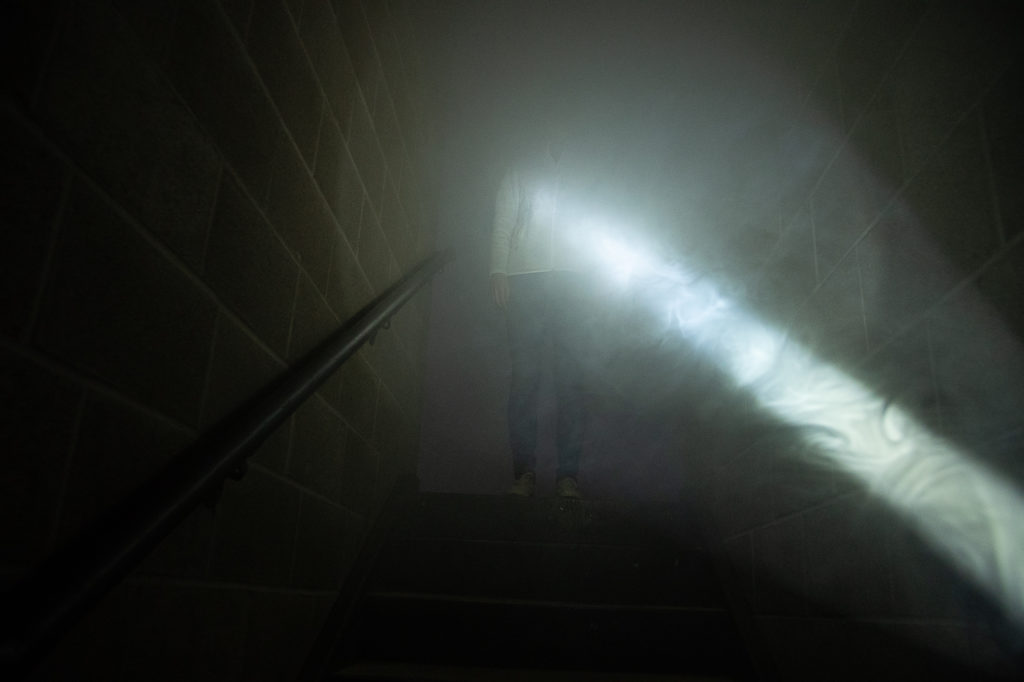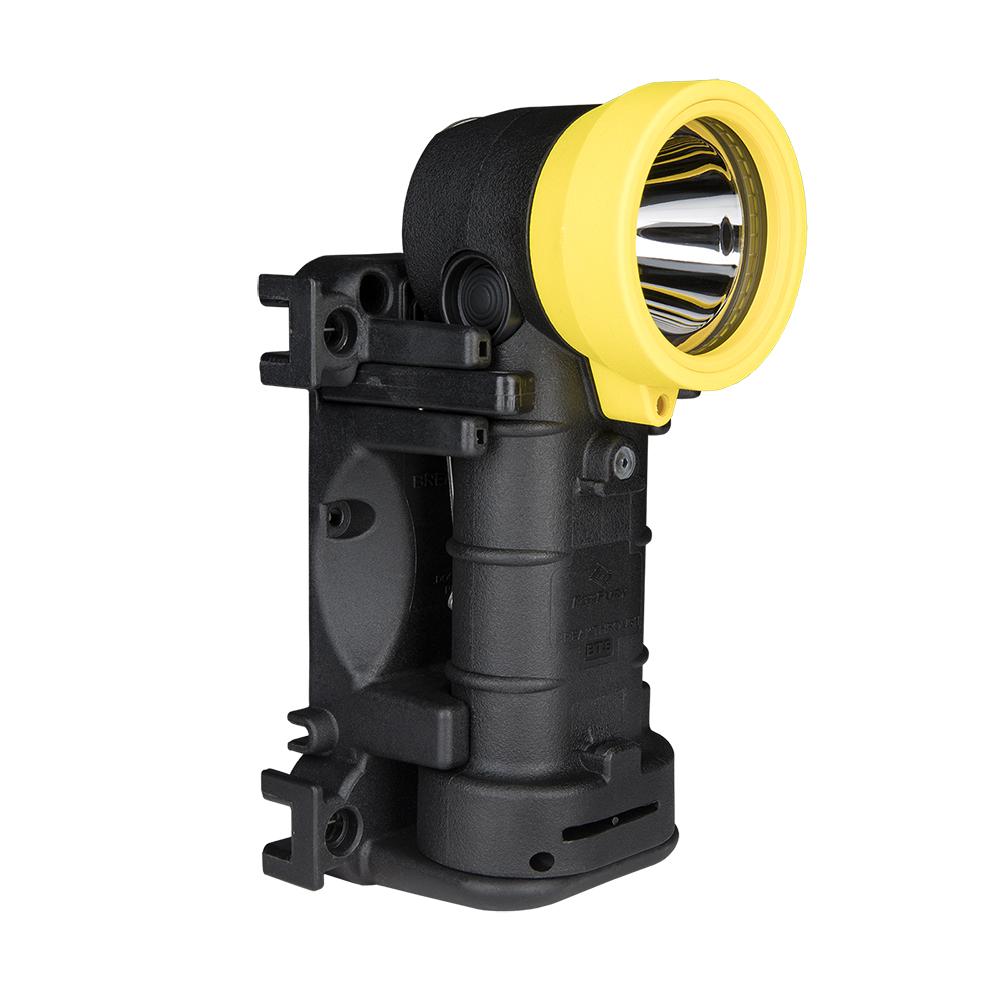Shop by Industry
Industries we support...
Products
START SHOPPING...
EXPLORE by category
Product Series
Resources
Contact
Find a Dealer
This guide outlines the need for right angle lights, lumens, beam angles, batteries, runtime, and the most important features to consider.
Right angle lights are considered the firefighter’s primary light source. These L-shaped lights were first developed in the early 1900s and used by soldiers in World War II and the Vietnam War. These chest-worn lights utilized heavy D cell batteries but enabled hands-free operation in low light conditions.
Over time, these lights were engineered to have tighter beams, power sources, and LED technology that helped cut through smoke in structural fires. Traditionally, the right angle light is the main lighting tool. It has been a mainstay in the fire service for decades. The right angle light is compact to be worn on the turnout. It features a powerful, tight beam that is ideal for search or cut through thick smoke. It’s L-shape is easy and natural to hold, even with heavy fire gloves.
If you are working on structure fires, the right angle light is a great option for your lighting needs. You will be working in the interiors of buildings with heavy smoke. Right angle lights have a tight, strong beam that will cut through the smoke and not illuminate it in front of you.
Right angle light is effective when reading smoke from below. If it creates a halo light, it is better to illuminate a larger area to determine the smoke's direction and speed.
At some point, you will be searching for victims, which requires you to see across a smoke-filled room or a field of collapsed debris. You need that tight, powerful beam to locate people quickly.

If you are doing many medical calls or close up tasks, a right angle light may not be an ideal light. First, you have to handhold it to direct the light where you need it, which compromises the use of both of your hands. Second, it can be an overpowering source of light working at short distances. A helmet light is better to illuminate the immediate area in front of you.
Brightness is probably one of the primary considerations when most choose a right angle light. It needs to cut through the blackest of smoke. It needs to shine down a ravine to see victims of a car crash.
Typical lumens of right angle lights range between 200-1000 lumens. If you are doing many medical or short-range task work, 200-400 lumens will be sufficient. If you are doing long-range search or interior structure fires, a light with 400-1000 lumens will be better.
The beam angle of a right angle light will typically be between 4 and 20 degrees. A tighter beam will typically cut through smoke better. A tighter beam will also throw light further. The disadvantage to a really tight beam is it reduces the overall illumination of a scene. You may not see objects in the dark peripheral areas.
Don't undervalue durability. If you choose not to utilize a redundant light system, your right angle light may be your only light source. If it fails, not only you but your crew and the potential victims could be seriously compromised.
Your light needs to be able to handle extreme heat, repeated impacts, and water. It needs to meet NFPA 1971-8.6 fire resistance standards. For waterproofness, it should have at least an IPX7 rating. And then it should have an impact-resistant design that can handle repeated drops, kicks, door slams, and anything else you will subject it to daily.
Construction materials should be heavy duty. Look for materials like nylon and stainless steel that will be able to stand up to repeated abuse. Hinges, moving parts, and removable features tend to break.
Simplistic design is key. Light manufacturers tend to add a lot of "innovative" features and adjustments to sell lights. The truth is; people don't use half of those features. You are focused on your work, and time is precious. There are only 1 or 2 items that you will adjust. Determine the core features that you will use regularly. Then choose your light based on those features.
Take special consideration to your battery compartment closures. If your batteries fall out of your light on the fire ground, your light will be useless until the end of the job. Make sure the compartment closure is solid and will lock securely. Avoid lights that have plastic hinges that will fatigue and break over time.
AA alkaline batteries are the gold standard in the fire service. They are used in lights, radios, cameras, and a variety of other electronics. Departments often supply bricks of AAs for the crew. It's a safe bet to source a headlamp that uses AA batteries.
Rechargeable battery packs and NiMH AA are other options. Rechargeable batteries will run longer than alkaline batteries. They also require you to manage the charging of the batteries. Make sure you have extra batteries charged and accessible when you are working long shifts. Know the runtime on your rechargeable battery. If it runs out of power, you can't replace it, and you'll need to recharge it. It's good to have a backup light in those situations.

Whatever choice you make on batteries, make sure you have access to backup batteries. You don’t want to get left in the dark at the most critical time.
Some lights are using lithium batteries to achieve a high lumen output and smaller size. This technology is awesome, but it does come at a cost. The price of a brighter smaller light is runtime. Ensure you know what the actual runtime is, so you don't get caught halfway through your shift with a dead light.
Next to your SCBA and turnout, your right angle light may be one of your most important tools in your day to day service. You use it for reading smoke, searching for victims, and assessing the medical conditions of patients. When choosing a right angle light, make sure you determine what YOU need it to do. Think about what most of your calls are and what your lighting needs are.
Look at the construction and materials of the light. It should feel solid and be able to handle the day to day abuse you will put it through. The design should be functional. You should be able to handle the light and turn it on or off with fire gloves. When it's attached to your turnout, it is secure and won't come off accidentally. When you do need to pull it off, you should need to fight the light.
Choose your battery sources wisely. Weigh the pros and cons of weight vs performance. Lighter weight lights and batteries come at the cost of runtime and price. The last thing you need is for your light to fail you at the most inopportune time.
To learn more about other lights that are used in the fire service, head over to our Complete Guide to Lights for Firefighters. There's a lot of information about features, ratings, batteries, and techniques to help you make the right choice on your next lights.



Enter your details below to save your shopping cart for later.